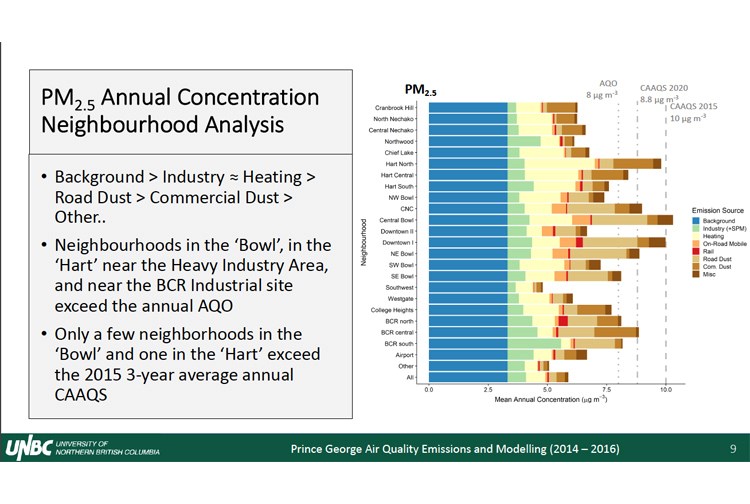The Prince George airshed has seen significant reductions in industrial air pollution, but levels of fine particulate matter still exceed provincial health standards in 10 city neighbourhoods, according to a new UNBC study.
On Monday, UNBC researcher Peter Jackson presented the results of an air quality emissions and modelling study to city council. The study, which looked at data from 2014 to 2016, found industrial emissions of fine particulate matter (PM 2.5) had dropped by 40 per cent since the last study in 2005. Industrial sulphur dioxide emissions had also decreased by 24 per cent over the same period.
"The emissions is what goes into the air, but what we care about is the air we breath," Jackson said. "Industry has been spending a lot of money and putting in a lot of effort to reduce emissions."
However, Jackson said, industrial sources continue to be the single-largest sources of fine particulate matter in the city, followed by residential heating – meaning wood stoves.
"Natural gas contributes very little in terms of particulate matter," he said. "In some neighbourhoods, like North Hart, that (wood burning appliances) are the dominate source."
While industrial emissions are fairly steady throughout the year, wood burning can be a major source of air pollution in the winter months, he said.
The B.C. Ministry of Environment and Climate Change Strategy calls fine particulate matter (PM 2.5) "one of the most important outdoor air pollutants in B.C. from a human health perspective."
The province's air quality objective for PM 2.5 is no more than eight micrograms per cubic metre on a annual average basis, and no more than 25 micrograms per cubic metre in a single 24-hour period.
"(It) is recognized that these levels are not necessarily protective of human health given scientifically-based evidence that there is no lower threshold limit for PM 2.5 effects on human mortality and morbidity," a provincial study conducted in 2006 said. "In fact, the Federal-Provincial Working Group on Air Quality Objectives and Guidelines (WGAQOG) has determined that the target which would substantially reduce the risks to human health for PM 2.5 is 7.5 (micrograms per cubic metre of air)."
The UNBC model predicts that annual average fine particulate matter levels exceeded the provincial standard in 10 out of 23 neighbourhoods in the city.
The central, northeast and southeast areas of the bowl; north and central Hart; north, south and central BCR area; some parts of downtown; and area around the College of New Caledonia were all predicted to exceed the provincial annual air quality objectives. Six of the 10 were also projected to exceed the less-stringent national standard of 8.8 micrograms per cubic metre of air.
The Cranbrook Hill, North Nechako, Central Nechako, Northwood, Chief Lake, south Hart, northwest and southwest bowl, some sections of downtown, southwest, Westgate, College Heights and airport areas were all predicted to be below the provincial standard.
The study was conducted by Jackson and graduate student Brayden Nilson. The city, Prince George Air Improvement Roundtable and Northern Health helped fund the the study, with technical support from the provincial and federal governments.
The study looked at the 2014 to 2016 period because there was relatively low levels of wildfire smoke to skew the results, Jackson said.
"We've modelled every hour for the three-year period," he said.
Once the gigabytes of computer modelling data was completed, they compared their results to air quality data recorded at the province's air quality monitoring stations at Plaza 400 and Gladstone. The model's predictions were fairly close to the recorded levels, he said. The model slightly overestimated PM 2.5 levels at Gladstone and slightly underestimated levels at Plaza 400 downtown.
"Models are always wrong, it's just a matter of how wrong," Jackson said.
However, the university is working on a new study to place 60 PM 2.5 air quality monitoring stations around the city to compare the model's predictions with extensive data, he said.
Coun. Garth Frizzell said he recalled when he was first elected air quality was the biggest election issue.
"We've come a long way," Frizzell said. "Most neighbourhoods are below the most stringent standard."



